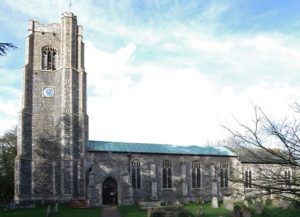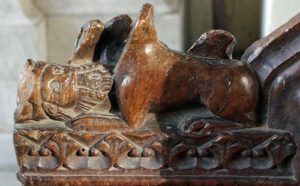The church stands on top of a hill overlooking the village. There has been a church and small priory (nothing left) on the site since before the Norman Conquest. Most of the present building is 14th/15thC Perpendicular. The tower was built by John de la Pole who is buried in a magnificent tomb in nearby Wingfield.
The chancel was rebuilt in the 19thC. Heavy buttresses on the outside of the north aisle, tie beams across the roof and a lopsided chancel arch suggest there has been problems with movement.
According to legend, St Edmund King of East Anglia was killed by the Danes near Hoxne. His head was cut off and thrown into the woods. When his followers searched for his head they found it being guarded by a wolf. This is regarded as a major selling point of the church and inside the porch are instructions to find the medieval pew end of the wolf guarding St Edmund’s head. (Walk towards the altar and turn left at the end of the choir stalls. The pew end is on the left.) Unfortunately the wolf has now lost his head. In Thornham Parva there are wall paintings telling the story of the martyrdom of St Edmund.
Inside, the nave is low and has short octagonal pillars with pointed arches into the north aisle. This is now a bit of a dumping ground, containing glass cases and information panels.
Above the arches on the north wall are the remains of wall paintings. These are poorly preserved and parts are missing. On the left is St Christopher although all that is left is his red cloak. Next is the Seven Deadly Sins portrayed as a tree. Only three ‘branches’ are left. Beyond this is the Seven Acts of Mercy. There are five figures but it is difficult to make out much detail. The final picture is between the fourth and fifth windows and is supposed to be the Last Judgement. This is in very poor condition and we couldn’t work out any detail.
At the back of the church is a traditional East Anglian font with symbols of the four evangelists and angels with shields, including the de la Pole arms. There are carved angel heads below the bowl and clerics carved round the base. Above it has a very tall wooden steeple lid with a pulley and weight to lift it.
There is a simple beam roof in the nave. That in the chancel is more elaborate with wooden shields carved on the ends of the beams which are supported on stone angel heads.
The 14thC iron bound chest at the west end of the church was the parish strong box and was secured by seven locks, one for each trustee of the parish.
The pews are 19thC and lack decoration. On the south wall is a monument under a pinnacled canopy to Sir Edward Kerrison who died in 1850. He fought in the Battle of Waterloo and was MP for the Borough of Eye.
There is a simple table altar contains the original Purbeck marble altar slab which had been removed in the Reformation and left lying on the sanctuary floor. Behind it is open carved wooden arch, all that remains of an earlier screen. The east window contains 19thC glass.
This is an unexceptional church with a very tall square flint tower, low nave, chancel and south aisle. The wall paintings although extensive are poorly preserved. It is worth visiting if in the area but doesn’t warrant a special journey. It is open 9-4 and there is parking behind the church.









